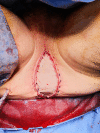A Low rectal GIST
- PMID: 35288433
- PMCID: PMC8921934
- DOI: 10.1136/bcr-2021-248505
A Low rectal GIST
Abstract
A man in his 70s presented with narrowing of his stool calibre and a palpable mass on rectal examination. Colonoscopy revealed a submucosal bulge without a mucosal lesion. CT and MRI demonstrated an 8×5.4×7 cm mass in lower rectum. Biopsy of the mass confirmed a rectal gastrointestinal stromal tumour (GIST). It was moderately sensitive to neoadjuvant imatinib and radiotherapy, which slightly downsized the tumour. He required abdominal perineal resection with curative intent. Uncommonly found in the rectum, when located here, GISTs are typically aggressive and are a rare cause of stool calibre narrowing. Rectal GISTs should be considered in patients presenting with this symptom.
Keywords: gastrointestinal surgery; gastrointestinal system; malignant disease and immunosuppression; radiology (diagnostics).
© BMJ Publishing Group Limited 2022. No commercial re-use. See rights and permissions. Published by BMJ.
Conflict of interest statement
Competing interests: None declared.
Figures








References
-
- Network NCC, 2021. Available: https://www.nccn.org/professionals/physician_gls/pdf/gist.pdf [Accessed 1 Dec 2021].
Publication types
MeSH terms
Substances
LinkOut - more resources
Full Text Sources
